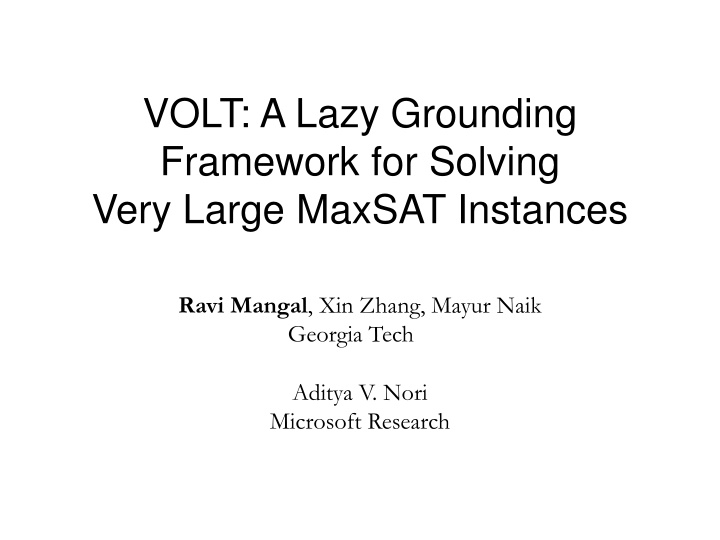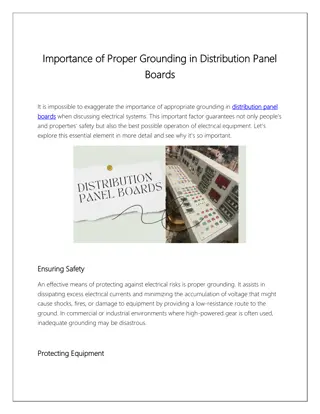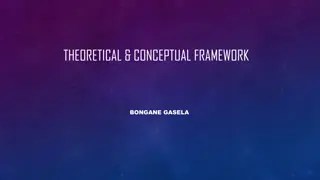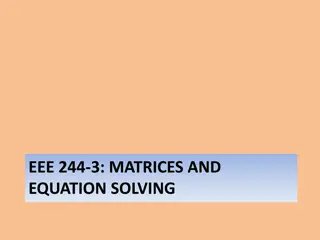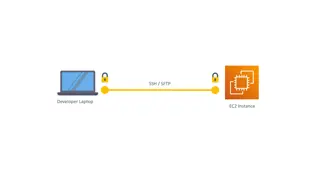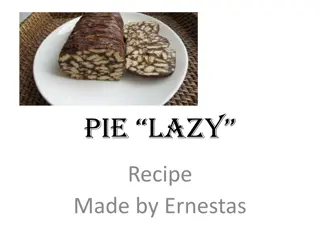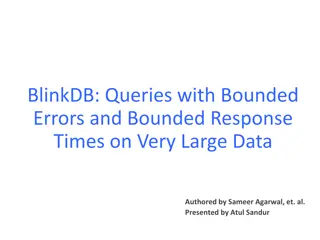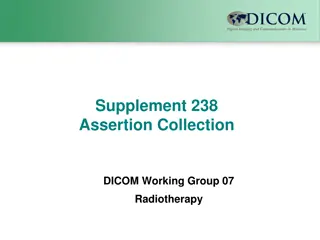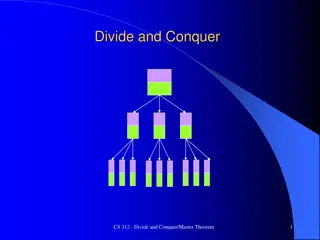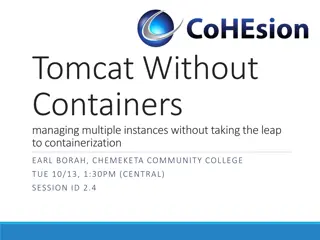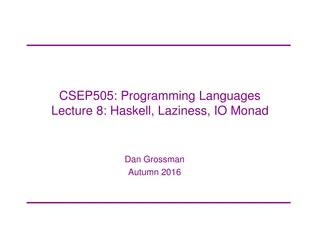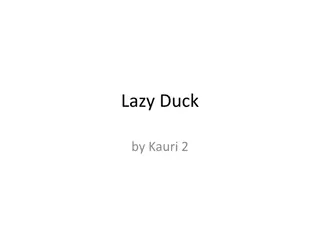Lazy Grounding Framework for Solving Very Large MaxSAT Instances
This paper presents VOLT, a lazy grounding framework developed by Ravi Mangal, Xin Zhang, and Mayur Naik from Georgia Tech, and Aditya V. Nori from Microsoft Research. VOLT aims to efficiently solve very large MaxSAT instances by utilizing innovative grounding techniques. The framework offers a promising approach to address the challenges associated with solving complex optimization problems. With its focus on scalability and performance, VOLT presents a significant contribution to the field of computational optimization.
Download Presentation

Please find below an Image/Link to download the presentation.
The content on the website is provided AS IS for your information and personal use only. It may not be sold, licensed, or shared on other websites without obtaining consent from the author.If you encounter any issues during the download, it is possible that the publisher has removed the file from their server.
You are allowed to download the files provided on this website for personal or commercial use, subject to the condition that they are used lawfully. All files are the property of their respective owners.
The content on the website is provided AS IS for your information and personal use only. It may not be sold, licensed, or shared on other websites without obtaining consent from the author.
E N D
Presentation Transcript
VOLT: A Lazy Grounding Framework for Solving Very Large MaxSAT Instances Ravi Mangal, Xin Zhang, Mayur Naik Georgia Tech Aditya V. Nori Microsoft Research
MaxSAT in Program Analysis Analysis Engine Analysis Spec Program MaxSAT Solver Analysis Result SAT 2015 3/3/2025
Two MaxSAT Applications in Program Analysis Find Suitable Abstraction to Prove Assertions Adapt Program Analysis to User Feedback Hard Clauses Sound Inference Rules of Underlying Analysis Relative Costs of Different Abstractions Relative Confidences of Analysis Writer and User Soft Clauses Zhang, Mangal, Grigore, Naik, Yang. On Abstraction Refinement for Program Analyses Using Datalog. Programming Langauge Design and Implementation (PLDI) 2014 Mangal, Zhang, Nori, Naik. A User-Guided Approach to Program Analysis. Foundations of Software Engineering (FSE), 2015 SAT 2015 3/3/2025
Challenge: Solving very large MaxSAT instances Program size (KLOC) Total number of clauses Datarace Analysis 2.4 x 1024 Pointer Analysis 2.9 x 1029 antlr 131 1.8 x 1026 1.8 x 1031 avrora 193 3.7 x 1023 1.7 x 1028 ftp 130 1.9 x 1024 6.2 x 1028 hedc 153 1.6 x 1025 1.2 x 1030 luindex 190 1.7 x 1025 1.2 x 1030 lusearch 198 4.4 x 1024 3.0 x 1029 weblech 194 SAT 2015 3/3/2025
VOLT: Lazy MaxSAT Solver Framework Lazy, iterative framework that calls existing MaxSAT solvers in an outer loop In each iteration, only a small, relevant subset of the entire MaxSAT instance is considered Basic intuition: most clauses are trivially satisfied by assuming a false value for the variables Many lazy approaches proposed by AI and PL communities SAT 2015 3/3/2025
VOLT: Lazy MaxSAT Solver Framework No Yes SAT 2015 3/3/2025
VOLT: Framework Instantiations SoftCegar CPI Alchemy/ Tuffy AbsRefine SAT 2015 3/3/2025
Example v1 weight 100 v2 weight 100 v4 weight 100 v6 weight 100 v1 v3 weight 5 v2 v3 weight 5 v3 v4 weight 5 v3 v5 weight 5 v5 v6 weight 5 ... ... SAT 2015 3/3/2025
Example: Iteration 1 of 6 v1 weight 100 v2 weight 100 v4 weight 100 v6 weight 100 v1 v3 weight 5 v2 v3 weight 5 v3 v4 weight 5 v3 v5 weight 5 v5 v6 weight 5 ... ... Solution: empty SAT 2015 3/3/2025
Example: Iteration 2 of 6 v1 weight 100 v2 weight 100 v4 weight 100 v6 weight 100 v1 v3 weight 5 v2 v3 weight 5 v3 v4 weight 5 v3 v5 weight 5 v5 v6 weight 5 ... ... Solution: v1 = T, v2 = T SAT 2015 3/3/2025
Example: Iteration 3 of 6 v1 weight 100 v2 weight 100 v4 weight 100 v6 weight 100 v1 v3 weight 5 v2 v3 weight 5 v3 v4 weight 5 v3 v5 weight 5 v5 v6 weight 5 ... ... Solution: v1 = T, v2 = T, v3 = T SAT 2015 3/3/2025
Example: Iteration 4 of 6 v1 weight 100 v2 weight 100 v4 weight 100 v6 weight 100 v1 v3 weight 5 v2 v3 weight 5 v3 v4 weight 5 v3 v5 weight 5 v5 v6 weight 5 ... ... Solution: v1 = T, v2 = T, v3 = T, v4 = T, v5 = T SAT 2015 3/3/2025
Example: Iteration 5 of 6 v1 weight 100 v2 weight 100 v4 weight 100 v6 weight 100 v1 v3 weight 5 v2 v3 weight 5 v3 v4 weight 5 v3 v5 weight 5 v5 v6 weight 5 ... ... Solution: v1 = T, v2 = T, v3 = T, v4 = F, v5 = T, v6 = T SAT 2015 3/3/2025
Example: Iteration 6 of 6 v1 weight 100 v2 weight 100 v4 weight 100 v6 weight 100 v1 v3 weight 5 v2 v3 weight 5 v3 v4 weight 5 v3 v5 weight 5 v5 v6 weight 5 ... ... Solution: v1 = T, v2 = T, v3 = T, v4 = F, v5 = T, v6 = F SAT 2015 3/3/2025
Evaluation Setup 4 real-world program analysis benchmarks 6 best performing and freely available solvers from MaxSAT 2014 competition Linux server with 64GB RAM and 3.0GHz CPU Timeout of 5 hours for MaxSAT solver in each iteration SAT 2015 3/3/2025
Evaluation Results solver total time (min) # iterations avg solver time (secs) # final clauses # total clauses CCLS2akms - 1 - 7.8M Eva500a 124 15 64.8 10.4M antlr MaxHS 117 14 71.2 10.1M 8.5 x 1035 wmifumax 109 14 44.4 10.3M MSCG - 5 22.2 7.9M WPM-2014-co 115 14 40.3 10.3M CCLS2akms - 1 - 4.6M Eva500a 127 14 78.6 14.7M MaxHS 144 14 123.1 19.1M lusearch 1 x 1037 wmifumax 119 15 51.2 10.2M MSCG - 6 17 7.5M WPM-2014-co 196 14 332.7 16M SAT 2015 3/3/2025
Empirical Results solver total time (min) # iterations avg solver time (secs) # final clauses # total clauses CCLS2akms - 1 - 7M Eva500a - 4 80.2 17.6M avrora MaxHS - 13 136.7 15.5M 4 x 1037 wmifumax - 13 115.1 9.1M MSCG - 5 31.6 16.9M WPM-2014-co - 12 2135.9 14.8M CCLS2akms - 1 - 10M Eva500a - 5 96.6 19.2M MaxHS - 18 571.6 > 4290M xalan 3.8 x 1039 wmifumax - 14 78.7 42.9M MSCG - 5 47.6 19.7M WPM-2014-co - 12 505.7 44.3M SAT 2015 3/3/2025
Conclusion Program analyses are increasingly using MaxSAT solvers MaxSAT instances generated by program analyses can be beyond the scope of the existing solvers Lazy, iterative techniques are a promising approach VOLT, a framework for expressing lazy techniques, can be used for future research in this area SAT 2015 3/3/2025
